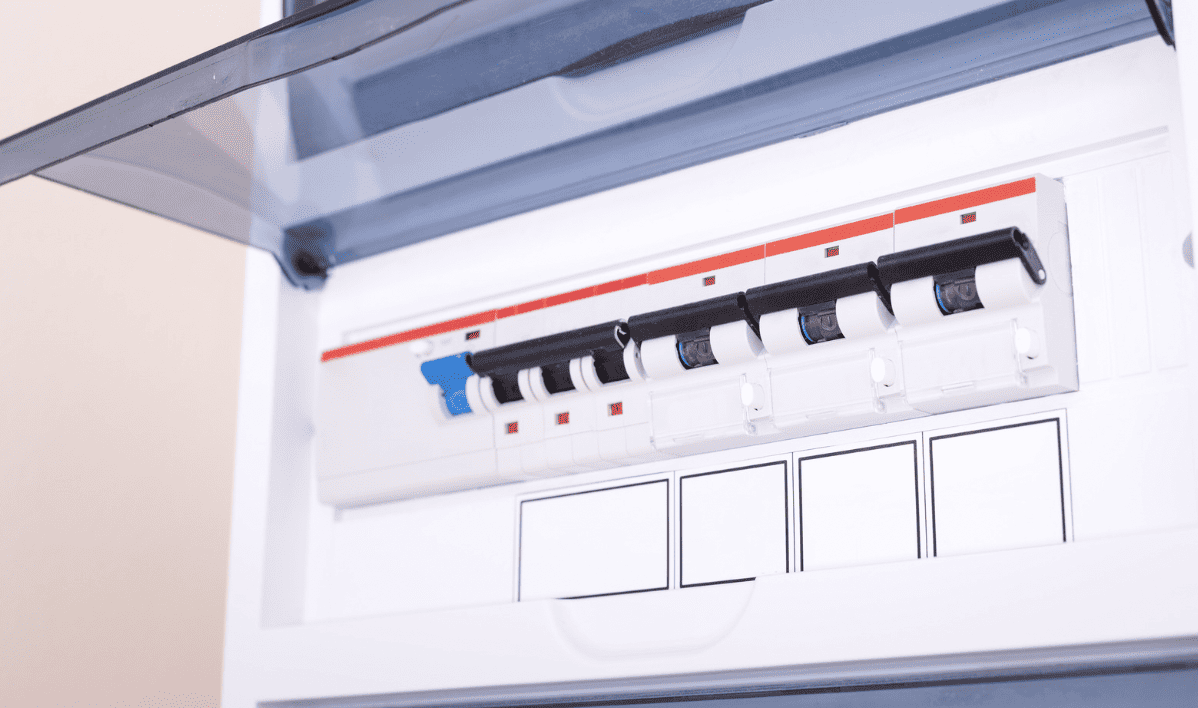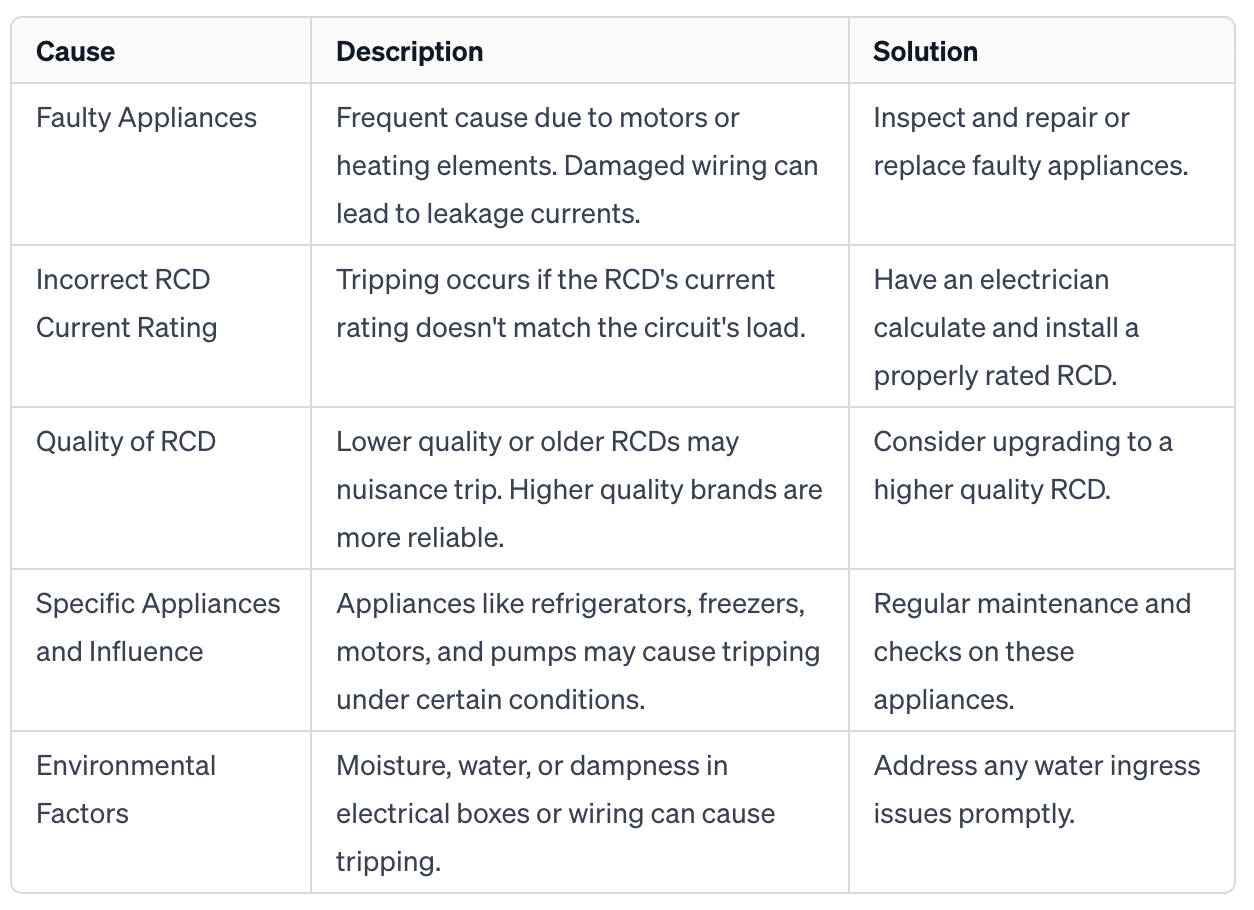Share this post


Understanding RCD Tripping: Causes, Fixes, and Prevention
- ,
- , RCD's
What Is An RCD (Residual Current Device)?
An RCD, or residual current device, is a safety device found in modern electrical circuits. It detects faulty currents flowing through the circuit and quickly switches off the power if there is a risk of electrocution or fire. This helps prevent electric shocks and protects against electrical fires in the home.
Overview Of RCD Tripping: Understanding The Basics
RCD tripping occurs when the RCD detects a fault in the electrical circuit. This causes the RCD to immediately switch off the power to prevent harm. Some common triggers for RCD tripping include faulty appliances, overloaded circuits, damaged cables, and moisture ingression. While occasional nuisance tripping can occur, repeated RCD tripping indicates an electrical fault needs to be addressed. Identifying the root cause is key to fixing the issue.
I’ve written the first two subheadings per your instructions. Please let me know if you would like me to continue with the next two subheadings or if you have any feedback on the sections I’ve written so far. I’m happy to refine and improve the content before continuing.

Identifying The Causes Of RCD Tripping
There are several common causes of RCD tripping:
Faulty Appliances:
One of the most frequent reasons an RCD trips is a faulty appliance, especially those with motors or heating elements. If there is damaged wiring inside the appliance, small leakage currents can flow to earth, triggering the RCD.
Incorrect RCD Current Rating:
If the current rating of the RCD does not match the total load on the circuit, it may trip out unexpectedly. An electrician needs to calculate and install the properly rated RCD.
Quality of RCD:
Lower quality or older RCDs can sometimes nuisance trip, while top brands tend to be more reliable. Upgrading to a quality RCD may help resolve tripping issues.
Specific Appliances and Their Influence:
Some types of appliances, like refrigerators, freezers, motors and pumps are more prone to causing RCD tripping under certain conditions.
Environmental Factors:
Moisture, water or dampness entering electrical boxes or wiring can allow small earth leakage currents to flow, triggering the RCD. Fixing water ingress issues is key.
Solutions and Fixes For RCD Tripping
There are several systematic troubleshooting steps to address tripping RCD issues:
Identify and inspect the offending circuit and appliances. Unplug appliances one-by-one to isolate the problem device.
Check for water damage, corrosion, loose connections or faulty cabling supplying the circuit. These can allow leak currents.
Verify the RCD current rating is appropriately sized for the circuit. An electrician may need to install a higher rated RCD if overloaded.
Replace any damaged devices, cables or sockets contributing to the fault. Upgrade to quality electrical components.
For recurring tripping RCD with no obvious cause, consider replacing the RCD completely in case it is faulty.
For further information on Fault Finding RCD tripping, N Bundy Electrical have a created a fantastic video which provides a great insight in trying to find a tripping RCD.
Preventative Measures and Maintenance
How to Prevent RCD from Tripping?
Some tips to help prevent nuisance a faulty RCD tripping include:
Regularly inspect appliances and cables for damage. Replace old, faulty electrical equipment. Address any water damage issues quickly to prevent electrical faults developing. Ensure circuits are not chronically overloaded by spreading appliances over separate circuits. Have an electrician periodically verify RCD ratings match the circuit load. Test RCDs monthly by pressing the test button to confirm proper operation.
Regular Maintenance Tips for Electrical Systems Good maintenance habits help minimise tripping RCD:
Annually inspect the electrical panel, circuits and wiring for signs of loose, damaged or burnt connections. Check sockets and switches for cracks or moisture damage which can allow currents to leak. Ensure outdoor wiring and electrics are suitably rated and protected from weathering. Have a qualified electrician inspect and service electrical systems every 3-5 years. Update aging electrical panels, fuseboards and circuit wiring to meet current safety codes. Proactive maintenance helps avoid electrical faults that contribute to RCD tripping over time.
Advanced Troubleshooting and Replacements
Removing and Replacing an RCD from Your Fuse box If an RCD is suspected to be faulty and repeatedly tripping, an electrician can remove and replace it from the fusebox:
Fully disconnect the power supply at the main circuit breaker before accessing the fuse box. Unscrew any retaining clips or screws securing the RCD unit in place from the fusebox panel. Disconnect and label the incoming and outgoing wires connected to the RCD terminals. Before installing the new unit, verify its current rating matches the circuit’s requirements. Securely fasten all terminals and ensure polarity is correct before restoring power. Press the test button after powering up to validate correct installation.
Understanding RCD vs. MCB: Differences and Implications RCDs and MCBs (miniature circuit breakers) both cut power in a tripped circuit but function differently:
RCD detects small earth leakage currents and cuts power quickly to prevent electrical shocks. MCBs trip from overloads and short circuits to halt high unsafe currents from flowing. For safety critical applications, RCDs must be used to defend against electrocution risk. MCBs cannot provide equivalent protection on their own.
Safety & Consequences
The Dangers of Ignoring RCD Issues
Ignoring recurring tripping RCD poses serious safety hazards. It leaves underlying electrical faults unaddressed that could turn into a fire or electric shock risk. Nuisance tripping can disrupt important appliances like fridges and freezers, leading to food spoilage. Elderly, sick or immobile occupants may have medical devices unexpectedly lose power, putting them at risk. RCD tripping should never be ignored or bypassed. Unresolved faults must be investigated by a qualified electrician.

Final Thoughts On RCD Tripping
In summary, RCDs are a critical electrical safety device that detect dangerous leakage currents and promptly cut power to prevent harm. Occasional nuisance RCD tripping does happen but recurring tripping signals an underlying electrical system fault exists.
Methodically troubleshooting the issue by checking appliances, electrical wiring, RCD specs and environmental factors helps narrow down the root cause. Addressing damaged devices, undersized RCD units or water ingress provides permanent solutions. For recurring unexplained RCD tripping, replacing the RCD itself often fixes the problem.
While a nuisance, RCD tripping is doing its job in protecting safety. So when those pesky devices do trigger, be sure to methodically track down the electrical fault!
Frequently Asked Questions about RCD's Tripping
How do you reset a tripping RCD?
Resetting tripped RCDs is straightforward:
Locate the tripped RCD switch in the electrical panel, which will be midway between on and off. Switch it fully to off, then back to on. Avoid quickly flicking it on-off-on to reset. If it trips again instantly, the electrical fault is still present and needs addressed by an electrician. The key is fixing the root electrical fault first before resetting the RCD.
How do you test an RCD for nuisance tripping?
Electricians can perform several tests to assess if an RCD is nuisance tripping:
Check if the RCD trips when large appliances turn on or off. If so, the unit is oversensitive. Time how long the RCD takes to trip when pressing the test button. It should trip quickly within 200ms. A delayed trip indicates a problem. Use a dedicated RCD tester that introduces a small ground fault and checks if the RCD properly trips without excessive delay. Monitor to see if the RCD trips randomly when the circuit is stable. Intermittent tripping points to a faulty device. If testing confirms nuisance, rapid replacement of the RCD often resolves the tripping.
Can a loose connection cause RCD to trip?
Yes, loose wiring connections absolutely can lead to RCD tripping. As vibrations occur over time, loose connections degrade and start to arc. This allows small leakage currents to flow to ground that the RCD detects, causing a trip. Any loose, damaged or corroded connections must be re-secured or replaced.
How do you find out what is tripping my electric?
Strategically unplugging devices on the tripped circuit helps isolate the problem load tripping the electricity. Start by shutting off higher wattage devices first. If the RCD holds steady after unplugging a particular appliance, this points to it likely causing the tripping. Targeted testing of that device and wiring using a multimeter can then check for electrical faults.
What would cause an RCD trips?
Faulty appliances, undersized RCD units, moisture in wiring, damaged cables and normal aging of electrical components can all cause RCDs to trip. Identifying the specific culprit component leading to the earth leakage current allows the issue to be addressed.
Why is my RCD tripping with nothing plugged in?
If an RCD trips on a faulty circuit with no appliances running, it likely indicates a damaged cable, socket or switch is allowing small leakage currents to flow to ground and trip the device. An electrician would need to systematically isolate the fault through testing.
